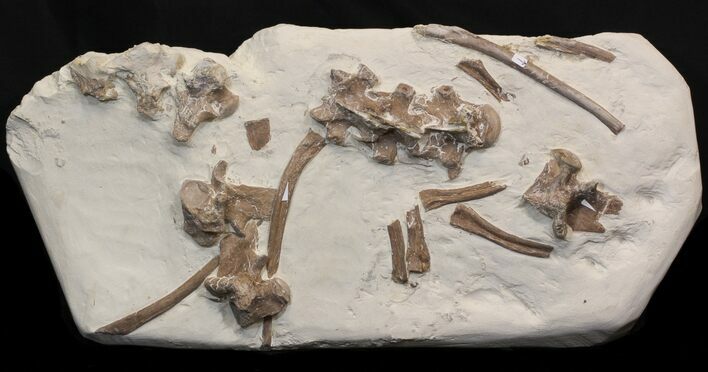This Specimen has been sold.
Mosasaur (Platecarpus) Bones With Shark Tooth Marks - Kansas
This is a group of associated Mosasaur (Platecarpus) ribs and vertebra from the Smoky Hill Chalk in Kansas. What is so interesting about this piece is many of the bones show signs of feeding by sharks. Several of the ribs on vertebra have deep scratch marks highlighted with the arrows in the photos. These likely would have been left by the large shark, Cretoxyrhina, though one can only guess if it's due to scavenging or predation.
The bones are in their original chalk matrix which measures 24x11" and is about 4" thick and weighs about 30lbs
Platecarpus is an extinct aquatic lizard belonging to the mosasaur family. Fossils have been found in the United States as well as a possible specimen in Belgium and Africa. It reached lengths of up to 14 feet long, half of that length being it's tail. Platecarpus probably fed on fish, squid, and ammonites. Like other mosasaurs, it was initially thought to have swum in an eel-like fashion, although a recent study suggests that it swam more like modern sharks.
The Smoky Hill Chalk Member of the Niobrara Chalk formation is a Cretaceous conservation Lagerstätte, or fossil rich geological formation, known primarily for its exceptionally well-preserved marine reptiles. It outcrops in parts of northwest Kansas, its most famous localities for fossils, and in southeastern Nebraska. Large well-known fossils excavated from the Smoky Hill Chalk include marine reptiles such as plesiosaurs, large bony fish such as Xiphactinus, mosasaurs, flying reptiles or pterosaurs (namely Pteranodon), flightless marine birds such as Hesperornis, and turtles. Many of the most well-known specimens of the marine reptiles were collected by dinosaur hunter Charles H. Sternberg and his son George.
The bones are in their original chalk matrix which measures 24x11" and is about 4" thick and weighs about 30lbs
Platecarpus is an extinct aquatic lizard belonging to the mosasaur family. Fossils have been found in the United States as well as a possible specimen in Belgium and Africa. It reached lengths of up to 14 feet long, half of that length being it's tail. Platecarpus probably fed on fish, squid, and ammonites. Like other mosasaurs, it was initially thought to have swum in an eel-like fashion, although a recent study suggests that it swam more like modern sharks.
The Smoky Hill Chalk Member of the Niobrara Chalk formation is a Cretaceous conservation Lagerstätte, or fossil rich geological formation, known primarily for its exceptionally well-preserved marine reptiles. It outcrops in parts of northwest Kansas, its most famous localities for fossils, and in southeastern Nebraska. Large well-known fossils excavated from the Smoky Hill Chalk include marine reptiles such as plesiosaurs, large bony fish such as Xiphactinus, mosasaurs, flying reptiles or pterosaurs (namely Pteranodon), flightless marine birds such as Hesperornis, and turtles. Many of the most well-known specimens of the marine reptiles were collected by dinosaur hunter Charles H. Sternberg and his son George.
SPECIES
Platecarpus
LOCATION
Gove County, Kansas
FORMATION
Niobrara Formation
SIZE
Plate 24x11", 4" thick
CATEGORY
SUB CATEGORY
ITEM
#40089
We guarantee the authenticity of all of our specimens.
 Reviews
Reviews


















